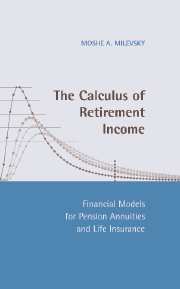Book contents
- Frontmatter
- Contents
- List of Figures and Tables
- I MODELS OF ACTUARIAL FINANCE
- 1 Introduction and Motivation
- 2 Modeling the Human Life Cycle
- 3 Models of Human Mortality
- 4 Valuation Models of Deterministic Interest
- 5 Models of Risky Financial Investments
- 6 Models of Pension Life Annuities
- 7 Models of Life Insurance
- 8 Models of DB vs. DC Pensions
- II WEALTH MANAGEMENT: APPLICATIONS AND IMPLICATIONS
- III ADVANCED TOPICS
- Bibliography
- Index
8 - Models of DB vs. DC Pensions
from I - MODELS OF ACTUARIAL FINANCE
Published online by Cambridge University Press: 06 July 2010
- Frontmatter
- Contents
- List of Figures and Tables
- I MODELS OF ACTUARIAL FINANCE
- 1 Introduction and Motivation
- 2 Modeling the Human Life Cycle
- 3 Models of Human Mortality
- 4 Valuation Models of Deterministic Interest
- 5 Models of Risky Financial Investments
- 6 Models of Pension Life Annuities
- 7 Models of Life Insurance
- 8 Models of DB vs. DC Pensions
- II WEALTH MANAGEMENT: APPLICATIONS AND IMPLICATIONS
- III ADVANCED TOPICS
- Bibliography
- Index
Summary
A Choice of Pension Plans
Would you like to have a pension that promised to pay you 60%–70% of your final salary for the entire duration of your retirement? Or would you rather be part of a pension arrangement that places 6% of your salary each year in a savings account and then lets you do whatever you want with the accumulated funds when you retire? This is the essence of the defined benefit (DB) versus defined contribution (DC) dilemma facing many individuals and corporations. Figure 8.1 provides a diagram of the two basic pension extremes and the various subcategories within the DB and DC world. On the leftmost side, the DB pension agreement—where the future benefit is defined—can be structured as an unfunded pay-as-you-go (PAYGO) plan in which current workers pay the pensions (via payroll and employment taxes) of retirees. In contrast, a funded DB plan is one in which funds are contributed and accumulated over time to pay the benefits of retirees. Whether the plan is fully funded, overfunded, underfunded, or PAYGO, there is a well-defined formula that links the actual retirement benefits to the number of years of work. In most cases, the financial risk (investment and longevity risk) is in the hands of the plan sponsor. They must make sure that, whatever they do with the funds, there is enough to pay pensions to retirees.
- Type
- Chapter
- Information
- The Calculus of Retirement IncomeFinancial Models for Pension Annuities and Life Insurance, pp. 164 - 182Publisher: Cambridge University PressPrint publication year: 2006



